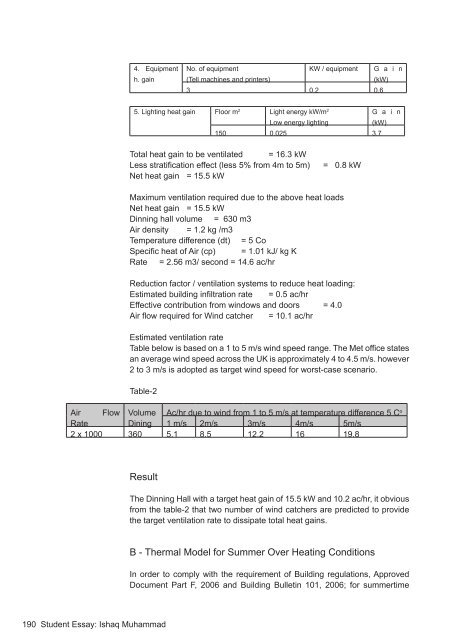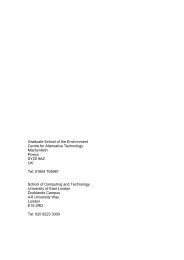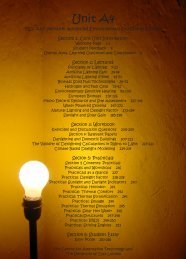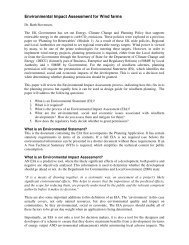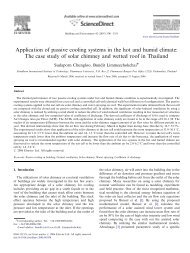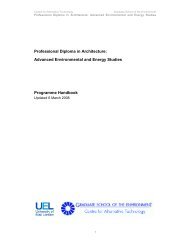Module B1 Study Book - the Graduate School of the Environment
Module B1 Study Book - the Graduate School of the Environment
Module B1 Study Book - the Graduate School of the Environment
You also want an ePaper? Increase the reach of your titles
YUMPU automatically turns print PDFs into web optimized ePapers that Google loves.
4. Equipment<br />
h. gain<br />
No. <strong>of</strong> equipment<br />
KW / equipment G a i n<br />
(Tell machines and printers)<br />
(kW)<br />
3 0.2 0.6<br />
5. Lighting heat gain Floor m 2 Light energy kW/m 2<br />
G a i n<br />
Low energy lighting<br />
(kW)<br />
150 0.025 3.7<br />
Total heat gain to be ventilated = 16.3 kW<br />
Less stratification effect (less 5% from 4m to 5m)<br />
Net heat gain = 15.5 kW<br />
= 0.8 kW<br />
Maximum ventilation required due to <strong>the</strong> above heat loads<br />
Net heat gain = 15.5 kW<br />
Dinning hall volume = 630 m3<br />
Air density = 1.2 kg /m3<br />
Temperature difference (dt) = 5 Co<br />
Specific heat <strong>of</strong> Air (cp) = 1.01 kJ/ kg K<br />
Rate = 2.56 m3/ second = 14.6 ac/hr<br />
Reduction factor / ventilation systems to reduce heat loading:<br />
Estimated building infiltration rate = 0.5 ac/hr<br />
Effective contribution from windows and doors = 4.0<br />
Air flow required for Wind catcher = 10.1 ac/hr<br />
Estimated ventilation rate<br />
Table below is based on a 1 to 5 m/s wind speed range. The Met <strong>of</strong>fice states<br />
an average wind speed across <strong>the</strong> UK is approximately 4 to 4.5 m/s. however<br />
2 to 3 m/s is adopted as target wind speed for worst-case scenario.<br />
Table-2<br />
Air Flow Volume Ac/hr due to wind from 1 to 5 m/s at temperature difference 5 C o<br />
Rate Dining 1 m/s 2m/s 3m/s 4m/s 5m/s<br />
2 x 1000 360 5.1 8.5 12.2 16 19.8<br />
Result<br />
The Dinning Hall with a target heat gain <strong>of</strong> 15.5 kW and 10.2 ac/hr, it obvious<br />
from <strong>the</strong> table-2 that two number <strong>of</strong> wind catchers are predicted to provide<br />
<strong>the</strong> target ventilation rate to dissipate total heat gains.<br />
B - Thermal Model for Summer Over Heating Conditions<br />
In order to comply with <strong>the</strong> requirement <strong>of</strong> Building regulations, Approved<br />
Document Part F, 2006 and Building Bulletin 101, 2006; for summertime<br />
190 Student Essay: Ishaq Muhammad


